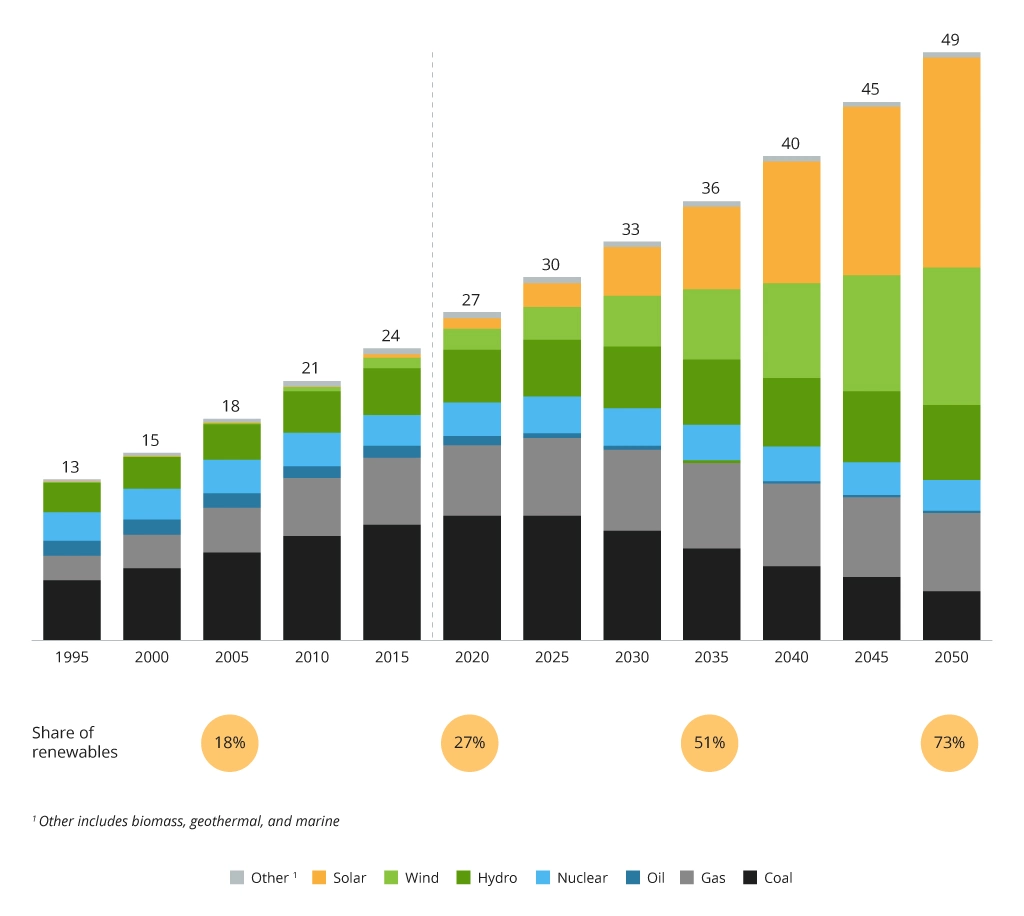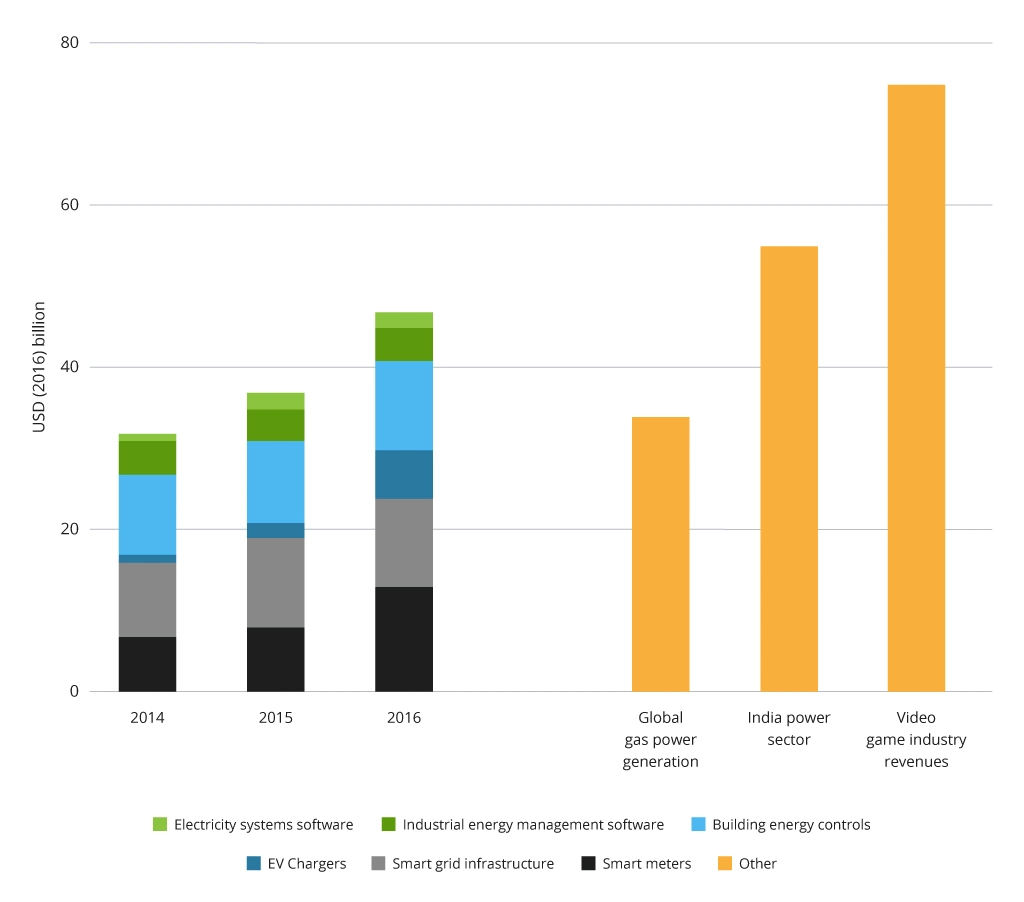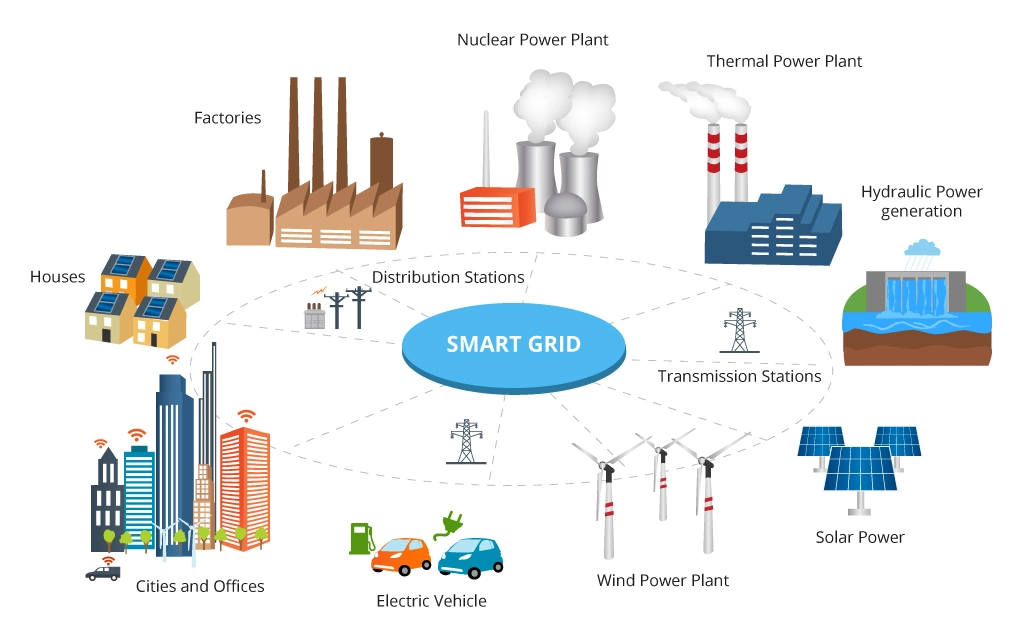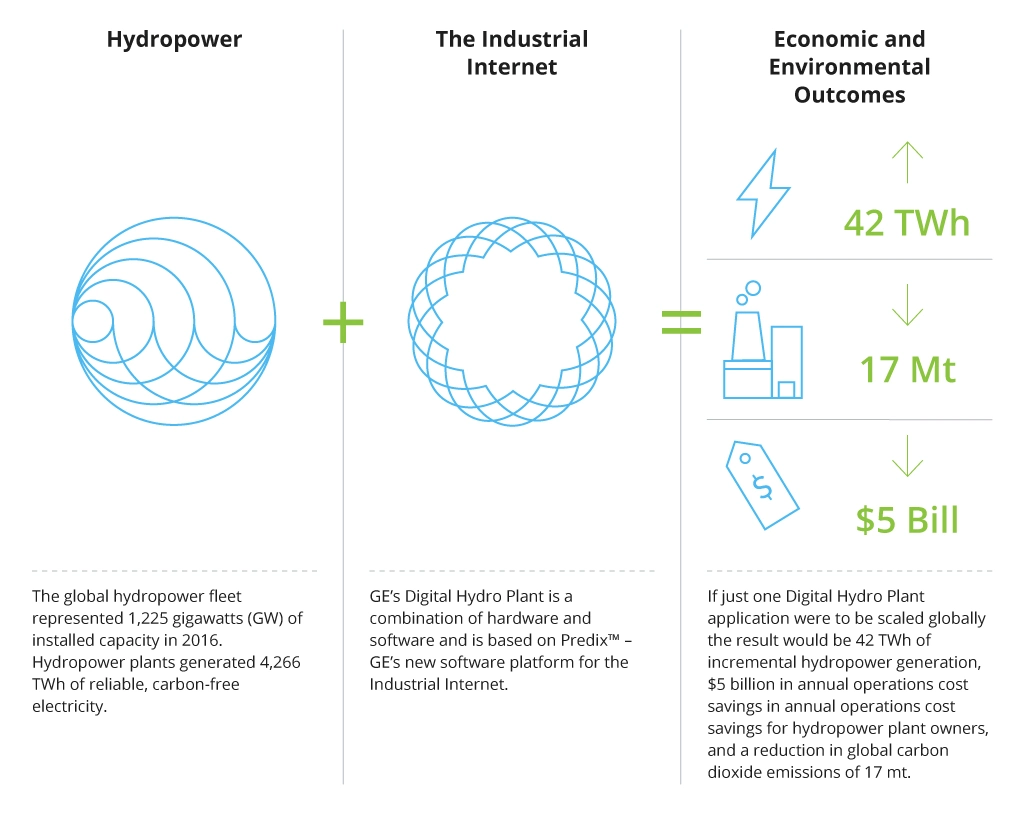The Future of Renewable Energy: IT Solutions by Industry
Facts and Numbers: Analysis of Renewable Energy Market
Today, renewable energy sources constitute 25% of the total energy market. According to McKinsey, renewable power will take over 50% of the market by 2035, with subsequent growth to nearly 75% of the global generation market by 2050.

The US market for alternative energy sources, which has been growing steadily throughout 2018-2019, serves as a great example of the market changes and key factors underpinning the industry growth:
- The declining cost of wind and solar power generation
- Increasing adoption of smart grids, and improved expertise in integrating different types of renewable energy into the grids.
- Improvements in battery storage
- Robust demand for renewable resources from different market segments.
In 2017, voluntary solar electric system installations represented 52% of utility-scale solar projects in development. This spike can be extrapolated to the corporations’ increasing demand for concentrated solar power and other renewable sources. Last year, US corporations purchased over 5 gigawatts of renewables, setting a new procurement record for this sector. State and local policies, as well as tax credits, are also bolstering further growth of the American renewable energy market. Both Hawaii and California set an ambitious goal to become 100% renewable by 2045. Additionally, mayors of over 200 communities announced their plans to transition to 100% renewable energy at the local level by 2035.
On a more granular level, consumers are also increasingly recognizing the benefits of renewable energy. Solar panel installations (individual and corporate) exceeded 2 million last year, and are likely to double by 2023. Furthermore, 53% of consumers put a large emphasis on having a certain share of their electricity supply coming from renewable energy resources. As a response, 48% of businesses now look into procuring more renewable electricity.
The appetite for renewable energy across the European market is going strong too. In 2018, the demand surpassed 500 TWh with France and Netherlands leading the numbers. Hydropower – the most common source – held a supply share of 56% in 2018, down from 64% in 2017 due to the increased availability of solar and wind energy. Additionally, as the Renewable Energy – Recast to 2030 directive entered into effect this year, the demand for biomass fuel and energy will likely rise within the next several years. Similar to the US, local initiatives are driving the growth of the sector. The Hague in the Netherlands has a goal to become 100% carbon-neutral by 2040, and open at least 4 geothermal heating plants in the city within the next 5 years. Several projects for geothermal heating and cooling of districts and facilities have been successfully executed in the following locations:
- Munich, Germany: a mini-plant providing heating for around 16,000 households.
- Paris, France: Orly airport created a geothermal power plant for heating its buildings.
- Thisted, Denmark: the local consumer-owned heating company created a geothermal plant for district heating.
The future for the renewable energy sector is promising in terms of demands and regulations. The bigger question, however, is whether suppliers can meet those ambitious targets.
How System-Wide Digitization Can Help Renewable Energy Companies Scale and Prosper
Due to being ‘natural’, renewable energy comes with a higher ‘uncertainty’ factor, making the plant operations and maintenance processes more complex. Unfavorable weather conditions can easily damage the wind turbines, but prolonged idle time is costly as well. On-site maintenance and repair works, especially in remote, hard-to-reach locations, can majorly uptick the operations bills and sink profitability.
Companies producing different types of renewable energy do use analytics, but in most cases, it’s descriptive and does not allow for real-time insights. Legacy monitoring systems are also losing their effectiveness as plants grow in size, grids become more complex and more participants join the renewable energy systems. Hence, market leaders are actively looking into new tech solutions:

As of 2018-2019, several other technologies moved to the fore of corporate investments in the domain:
- Cloud computing – the backbone for any digitization initiative, as it enables organization-wide connectivity and data-exchanges.
- Industrial IoT solutions enable plant operators to gather a variety of data on equipment performance (from temperature to sound and levels of vibration, etc.) and dispatch them for further analysis.
- Big data and predictive analytics – new-gen algorithms operationalize data collected from different sources (internal systems, IoT devices, external partners) and produce actionable insights in real-time. Such solutions can help prevent downtime, anticipate equipment failure and increase the value of energy production.
In the subsequent section, we provide a more in-depth overview of the new software solutions for renewable energy companies.
IT Solutions for Wind Energy Sector
Reliability and availability are crucial for wind farm operators as maintenance can be expensive and time-consuming. For instance, if a sudden failure occurs during unfavorable weather conditions, access to the wind plant may be limited, resulting in longer downtime and, as a result, profitability losses. By shifting to the newest powerful technologies such as IoT, Big Data and predictive analytics, wind farm operators can significantly and sustainably increase the wind turbine power outputs while reducing O&M costs. But wait, there’s more!
Digital twinning is another technology highly beneficial for the renewable energy sector. It allows creating virtual copies of physical systems, assets, and processes. A digital twin is a code-powered representation of an actual wind turbine that is constantly supplied with new data from its physical counterpart through connected systems.
A predictive algorithm, powering the twin, operationalizes all the incoming data and can be used to model different types of usage scenarios:
- Estimate performance and profitability under different conditions
- Ensure real-time monitoring and digital inspections
- Enable fault prediction and dynamic maintenance
- Facilitate and improve the work of on-site engineers, etc.
For instance, a Finnish wind farm operator, managing the northernmost wind turbine in the world, has successfully implemented a digital twin to reduce the need for physical inspections under harsh weather conditions.
GE Renewable Energy unit took the idea even further and developed a comprehensive predictive analytics suite that allows digitally replicating the infrastructure for a wind farm to collect and analyze asset-, farm- and fleet-level data. Additionally, the system gauges external data, including weather-, service- and performance reports of similar wind turbine models to enhance predictions.
In their recent case study, the company indicates that with their new system they managed to significantly reduce the downtimes and damages caused by planetary gear issues, resulting in $80,000 in total cost avoidance per event.
IT Recommendations for Wind Farm Operators
- Implement Digital Twining
- Wind Farm Siting Software enables advanced terrain analysis, 3D farm modeling and visualization.
- Turbine controller configuration management facilitates utilization and management of turbine parameter configurations to gauge asset performance.
- Other digital solutions for system integration support, lifetime extension, and cost reduction.
IT solutions for Solar Energy Industry
Big data analytics and IoT are having a transformational impact on the solar energy market as well. Solar energy systems can be equipped with IoT sensors, transmitting real-time performance data to one central control panel. This would allow the early detection of issues at the point of origin so that proactive measures could be taken before a system-wide failure occurs.
IoT enables remote diagnostics by collecting a wide array of hardware, network and environmental insights, further operationalized by predictive analytics algorithms. Additionally, some IoT-based solar projects are geared at improving the accuracy of metering, which can reduce the costs for both energy providers and consumers.
The digitization of solar power plants also introduces new business models. As residential solar panel installations experienced significant growth, and advanced metering infrastructures (AMIs) become more accessible, the solar energy market is shifting towards the Smart Grid model.

A smart grid is a system where all the actors (i.e. electricity generators, transmission and distribution operators, electricity consumers) communicate and collaborate effectively to improve the efficiency and reliability of the grid. The main goal here is to enable seamless correction of supply/demand imbalances in real-time, improve reliability and reduce costs.
Blockchain also plays a central role in the solar market as it helps improve existing business models, making them more cost-effective.
IT Recommendations for Solar Plant Operators
- Infrastructure support to augment operational capability: Collaborative Operations, Loop Tuning Optimization, Alarm Management & Rationalization, and Control System Health Check.
- Digital operations, maintenance and asset management: cloud computing for storing data; predictive analytics and maintenance; remote censoring and control; performance verification.
- Solar Grid Connectivity – digital integration with other ecosystem participants. Predictive energy management systems; storage management systems; smart home energy systems; solar trading software.
Hydropower IT Solutions
The digitization of hydropower plants can provide operators with actionable insights from data, contributing to better asset performance, increased efficiencies, minimized downtimes and ultimately the expansion of hydropower capabilities.
GE estimated that installing an intelligent condition management system can save a hydropower plant operator as much as $4,000 MW/year in terms of lower maintenance costs, enhanced asset life and improved operational efficiencies.
The leaders in the hydroelectricity space are now using a combination of software and hardware analytics to accurately measure and tune up the performance of their plants.

IT Recommendations for Hydro Plant Operators
- Industrial IoT and Big Data Analytics to enable comprehensive data collection and its subsequent transformation into actionable insights.
- Machine Learning and Deep Learning to forecast hydropower energy generation.
- Predictive Maintenance and Operation Optimization to minimize downtime and maximize performance.
- Digital Twins, powered by predictive analytics using physics-based models.
- Digitalization of the condition and risk assessment systems.
- Real-time reporting, visualizations and remote monitoring, enabled by digital twinning and big data analytics.
Bioenergy IT Solutions
The biomass energy market has a strong upward trajectory. The number of commissioned biomass power plants (BMPPs) grew to approx. 300 facilities in 2018, with the total number of BMPPs worldwide reaching 3,800 plants, producing around 60 GW. Up until 2027, the market for BMPPs is expected to see a steady period of growth with new projects being commissioned by governments worldwide. To meet the rising demand, bioenergy operators will need to focus on improving their operations.
New software emerges to automate and optimize the common processes such as fuel handling, flue gas cleaning, steam turbine performance, and electrical power distribution.
- Analytics-powered biomass calculators, for instance, can proactively evaluate the suitability of different feedstock types in your area and estimate the optimal biogas plant feeding.
- Biomass Design and Management Software can help determine the optimal plant size based on manure or energy crops available.
- Finally, implementing a Distributed Control System (DCS) majorly improves the plant operation and supervision processes by delivering real-time data from field and system peripherals, such as turbine auxiliary systems, refrigeration systems, steam boilers, biomass fuel supplies, dust filter systems, and other stand-alone units.
IT Recommendations for Biomass Plant Operators
- Optimize Biomass Supply Chain
- Migrate to Distributed Control system
- Integrate Biomass Design & Management software
- Implement Biogas Plant Simulation software
Conclusions
Commoditization of emerging technologies such as big data analytics, predictive analytics and IoT will help renewable electricity providers expand their operations and boost efficiencies to meet the rising market demand. The costs of supplying renewable energy are declining, and the infrastructure for transmitting and connecting renewable energy providers to the grids keeps improving. All of the above creates new opportunities across the electricity value chain.
If you’re ready to transform your approach to renewable solutions development, contact us today. Infopulse experts in IoT, BI, Big Data, and Predictive Analytics can help you bolster your strategy and expand capabilities.

![Pros and Cons of CEA [thumbnail]](/uploads/media/thumbnail-280x222-industrial-scale-of-controlled-agriEnvironment.webp)
![BPO in Telecom and BFSI [Thumbnail]](/uploads/media/thumbnail-280x222-ways-business-process-outsourcing-bpo-can-help-telecom-bfsi-and-other-industries-advance.webp)

![Power Platform for Manufacturing [Thumbnail]](/uploads/media/thumbnail-280x222-power-platform-for-manufacturing-companies-key-use-cases.webp)
![ServiceNow & Generative AI [thumbnail]](/uploads/media/thumbnail-280x222-servicenow-and-ai.webp)

![Data Analytics and AI Use Cases in Finance [Thumbnail]](/uploads/media/thumbnail-280x222-combining-data-analytics-and-ai-in-finance-benefits-and-use-cases.webp)
![AI in Telecom [Thumbnail]](/uploads/media/thumbnail-280x222-ai-in-telecom-network-optimization.webp)

![Data Analytics Use Cases in Banking [thumbnail]](/uploads/media/thumbnail-280x222-data-platform-for-banking.webp)